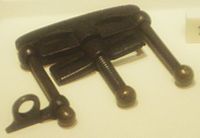This is an old revision of this page, as edited by OcelotHod (talk | contribs) at 01:02, 3 June 2015 (added Other terminology and In Pop Culture; citation for alternate term 'pillywinks' (note near-plagiaristic lines in the Intro); punctuation and links). The present address (URL) is a permanent link to this revision, which may differ significantly from the current revision.
Revision as of 01:02, 3 June 2015 by OcelotHod (talk | contribs) (added Other terminology and In Pop Culture; citation for alternate term 'pillywinks' (note near-plagiaristic lines in the Intro); punctuation and links)(diff) ← Previous revision | Latest revision (diff) | Newer revision → (diff)



The thumbscrew is a torture instrument which was first used in medieval Europe. It is a simple vice, sometimes with protruding studs on the interior surfaces. The victim's thumbs or fingers were placed in the vice and slowly crushed. The thumbscrew was also applied to crush prisoners' big toes. The crushing bars were sometimes lined with sharp metal points to puncture the thumbs and inflict greater pain in the nail beds. Larger, heavier devices based on the same design principle were applied to crush feet and ears.
Other terminology
The thumbscrew was also referred to as thumbkin or thumbikin (1675-1685), the "kin" part being a diminutive suffix of nouns. The term pillywinks was also used.
History
As late as the mid-18th century, the ex-slave Olaudah Equiano, in his autobiography The Interesting Narrative of the Life of Olaudah Equiano documented the use of thumbscrews to torture slaves. During this period (mid-18th century), Thomas Clarkson carried thumbscrews with him to further his cause for the abolition of the Slave Trade, and later emancipation of slaves in the British Empire. He hoped to, and did, inspire empathy with the display of this and other torture devices used on slaves. This form of torture was also used to exact confessions due to the excruciating pain it caused.
In medieval and Renaissance England, the thumbscrew was also utilized in a way that would straighten girls' fingers to make them look more elegant and elongated. It is recorded that there is a possibility that the nursemaid of Elizabeth I of England used this device on Elizabeth to create her elegant fingers. They were used on slave ships, as witnessed and described by Ottobah Cugoano and Olaudah Equiano.
In popular culture
The thumbscrew is shown in use in various media. Some examples are:
- James Whale's The Man in the Iron Mask, starring Louis Hayward (1939)
- the horror film Warlock, starring Julian Sands and Mary Woronov (1989)
- the "shockumentary" Faces of War, a collection of gruesome footage taken from wars throughout history (1999)
- the season 1 episode "The House of Pain" of the series Salem (2014)
References
- "Thumbkin". Random House Webster's Unabridged Dictionary / www.Dictionary.com Unabridged. 2015. Retrieved June 2, 2015.
{{cite web}}: Italic or bold markup not allowed in:|publisher=(help) - Brown, Peter C. (2014). Essex Witches. New York: History Press.
Many unfortunate women were condemned and hanged after undergoing appalling torture. The 'pillywinks' or 'pilnie-winks' (thumb screws) was a simple vice, which was sometimes fitted with protruding studs on the interior surfaces.
- ^ Equiano, Olaudah (1789). The Interesting Narrative of the Life of Olaudah Equiano, Or Gustavus Vassa, The African.
The iron muzzle, thumb-screws, &c. are so well known, as not to need a description, and were sometimes applied for the slightest faults.
- Hochschild, Adam. Bury the Chains: The British Struggle to Abolish Slavery (Basingstoke: Pan Macmillan, 2005)
- Smith, Mary-Antoinette (2010). Thomas Clarkson and Ottobah Cugoano: Essays on the Slavery and Commerce of the Human Species. Broadview Press. p. 36. ISBN 9781460402054. Retrieved August 11, 2014.
External links
This torture-related article is a stub. You can help Misplaced Pages by expanding it. |